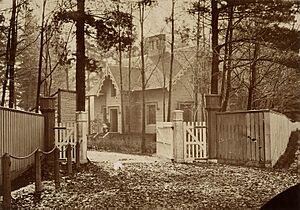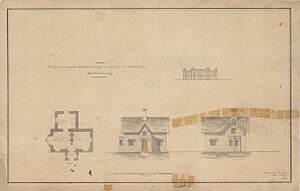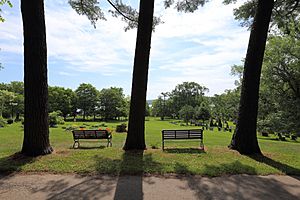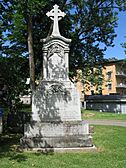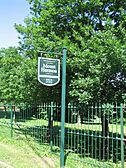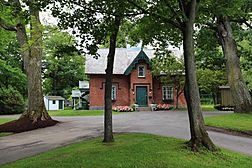Mount Hermon Cemetery facts for kids
Quick facts for kids Mount Hermon Cemetery National Historic Site of Canada |
|
|---|---|
| Native name French: Lieu historique national du Canada du cimetière Mount Hermon |
|
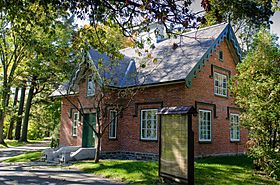
Entrance lodge
|
|
| Type | National Historic Site of Canada |
| Location | Quebec City, Quebec, Canada |
| Area | 11 hectares (26 acres) |
| Elevation | 60 m (196.85 ft) |
| Incorporated | 30 May 1849 |
| Founded | February 11, 1848 |
| Founder |
|
| Built | 1848 |
| Built for | Quebec City's Anglican community |
| Original use | Cemetery |
| Restored | 2011 |
| Restored by | Construction Couture & Tanguay inc. |
| Current use | Cemetery |
| Architect |
|
| Architectural style(s) |
|
| Owner | Mount Hermon Cemetery Association |
| Official name: Mount Hermon Cemetery National Historic Site of Canada | |
| Type | National Historic Site of Canada |
| Designated | 8 June 2007 |
| Reference no. | 11837 |
Mount Hermon Cemetery is a special kind of cemetery called a garden cemetery. It is also a National Historic Site of Canada. You can find it in the Sillery area of Quebec City, Quebec, Canada. In 2007, it was officially named a National Historic Site.
This 26-acre cemetery was created in the mid-1800s. At that time, Quebec City needed a new burial ground for its many Anglican (Protestant) residents who mostly spoke English.
The cemetery is located where Saint-Louis Road and côte de Sillery meet. It sits on a large piece of land that looks out over the Saint Lawrence River.
More than 17,000 people are buried at Mount Hermon. It's special because it was the first garden cemetery ever built in Canada. Like other garden cemeteries in North America, it was inspired by the famous Père-Lachaise Cemetery in Paris.
A memorial was put up for the people who died when the ship Empress of Ireland sank in 1914. Other memorials have been added over the years. The sinking of the Empress of Ireland was a huge tragedy. Mount Hermon and a nearby cemetery helped bury many of the ship's passengers who died.
There's also a special bell on the grounds called the Treggett Bell. It was given to the Treggett family to thank them. Members of four different generations of their family worked as the cemetery's Superintendents from 1865 to 2014.
The cemetery also has special sections for people of Greek, Chinese, and Cambodian backgrounds.
You can enter the main gate at 1801 Saint-Louis Road. There's also a walking entrance at the other end of the cemetery, on avenue des Voiliers. Inside, you'll find both paved and gravel roads.
Contents
How Mount Hermon Cemetery Started
In 1847, a group of Protestant business owners, shipbuilders, merchants, and religious leaders held a meeting. They wanted to find land for a new rural cemetery. Quebec City's old Anglican cemetery was full. City officials asked for a new Protestant cemetery to be built outside the city limits.
With help from John Gilmour, a well-known lumber merchant and local Protestant leader, the Quebec Protestant Cemetery Association was formed on February 11, 1848. Its first president was George O'Kill Stuart, Jr.. Their main goal was to raise money to buy land and create the cemetery. Other founding members included Jeffery Hale, who was known for his charity, and Dr. James Douglas, a doctor who joined the cemetery's first board of directors in 1848.
On June 14, 1848, Christopher Ferguson, a 42-year-old ship captain, died. He became the first person buried in the new cemetery. He was a member of the Church of England.
The new cemetery officially became a legal organization on May 30, 1849. It was at this time that it was given the name Mount Hermon.
The first board of directors was special because it showed different religious groups working together. This was important in Quebec, where most people were Roman Catholic. Between 1848 and 1883, out of 6,164 burials, almost half were members of the Anglican Church (2,991). The next largest groups were the Presbyterian Church (1,117) and the Methodist Church (583).
Designing the Cemetery
An American engineer named David Bates Douglass designed Mount Hermon's layout in 1848. Douglass was famous for designing Green-Wood Cemetery in Brooklyn, New York, which was known for its "peaceful countryside" feel. He used Green-Wood as a model for both Albany Rural Cemetery in New York and Mount Hermon Cemetery.
All three of Douglass's cemeteries were designed with the idea that cemeteries should be in peaceful, natural settings, far away from busy, crowded cities. These three garden cemeteries are now important historic places. Green-Wood Cemetery is a U.S. National Historic Landmark, and Albany Rural Cemetery is on the U.S. National Register of Historic Places.
Quebec City architect Edward Staveley designed the cemetery's Gothic Revival style entrance lodge and gates. His plans were signed on September 6, 1848.
When it was built, Mount Hermon was the first cemetery located in a rural area outside Quebec City's legal limits. It was also Canada's first garden cemetery. Later, on July 10, 1859, the Roman Catholic Notre-Dame-de-Belmont Cemetery opened nearby. This was the second garden cemetery built outside Quebec City.
Historic Importance
On June 8, 2007, Mount Hermon Cemetery was officially named a National Historic Site of Canada. It is also part of the Sillery Heritage Site, which became a historic district in 1964. On April 24, 2009, Parks Canada added Mount Hermon Cemetery to the Canadian Register of Historic Places.
The Historic Sites and Monuments Board of Canada recognized the cemetery's special value. They noted how art and nature blend together there. You can see Celtic crosses, neoclassical monuments, obelisks, and the Gothic-Revival style lodge. All of this is set in a "park-like space for public use." They also mentioned the many different tree species, winding paths, and great views of the Saint Lawrence River.
In 2011, the Mount Hermon Cemetery Association worked to restore the outside of the cemetery's entrance lodge. This building holds the Superintendent's office and home. They replaced the roof and added a new wooden staircase. They also restored the mass grave for the unknown victims from the Empress of Ireland shipwreck.
On November 5, 2015, the remains of 204 unknown people were reburied at Mount Hermon Cemetery. These remains were found by archeologists in 1999–2000 during restoration work at Saint Matthew's Church graveyard in Quebec City. These individuals had been buried at Saint Matthew's between 1772 and 1860.
A ceremony was held at Mount Hermon on September 8, 2016. It marked the 150th anniversary of Jeffery Hale Hospital. During the ceremony, new carvings on the Hale family monument and a new bench were revealed.
War Graves
The War Graves Photographic Project is a group of volunteers who record graves of Commonwealth service members who died since World War I. They have recorded details for 170 service members buried at Mount Hermon, including photos of their headstones. You can ask for copies of these photos from the group.
The Commonwealth War Graves Commission identified 68 people buried at Mount Hermon Cemetery who died during World War I and World War II. Of these, 49 were killed in action during World War I, and 14 during World War II. One of the World War II burials is an unknown Canadian airman. There are also three American war graves and one grave for an Austrian civilian who was interned. The Commonwealth burials in Section G are in Plot 1368.
Section G, in the northeast part of the cemetery, is called "The Canadian Armed Forces Section and the Memorial to three United States Army Airmen who died in 1942."
Gallery
Famous People Buried Here
Many interesting people are buried at Mount Hermon Cemetery. Here are a few:
Business Leaders
- James Bell Forsyth — A well-known Quebec lumber merchant and author. He built the beautiful Cataraqui Estate in Sillery around 1831.
- George Benson Hall Jr. (1810–1876) — A businessman involved in the lumber trade in Quebec. He was known as "one of Quebec’s most prominent and enterprising citizens."
- John Simons (1823–1906) — The person who started the famous Canadian retail company, La Maison Simons.
Education and Religion
- Bishop George Jehoshaphat Mountain — The third Anglican Bishop of Quebec. He was also the first principal of McGill University and the founder of Bishop's University.
- The Reverend George Weir (1825–1891) — A professor of Greek, Latin, Hebrew, and church history at Morrin College in Quebec City.
Government, Politics, and Law
- The Honourable Thomas Cushing Aylwin — A Quebec lawyer, judge, and political figure.
- Frank Carrel — A journalist, publisher, and politician.
- The Hon. Edward Bowen (1780—1866) — The first Chief Justice of the Superior Court for Quebec. He owned the land that became Mount Hermon Cemetery.
- Robert Christie (1787–1856) — A lawyer, journalist, historian, and political figure.
- James Bell Forsyth Jr. — The first mayor of Cap–Rouge and a businessman. He was the son of James Bell Forsyth.
- Colonel Bartholomew Conrad Augustus Gugy — A politician who represented Sherbrooke in the Legislative Assembly.
- Sir Henri-Gustave Joly de Lotbinière — He served as the fourth Premier of Quebec. He was also a federal Cabinet minister and the seventh Lieutenant Governor of British Columbia.
- John Lemesurier — A politician who was mayor of Quebec City from 1868 to 1869.
- The Hon. Sir William Collis Meredith — The second Chief Justice of the Superior Court of Quebec from 1866 to 1884.
- John Munn — A Scottish-born shipbuilder and political figure.
- Seigneur George Pozer — A merchant and landowner. He is considered the founder of Saint-Georges-de-Beauce.
- William Rhodes — A soldier, farmer, and political figure in Quebec.
- Dunbar Ross (around 1800—1865) — A lawyer and political figure.
- The Hon. James Gibb Ross — A merchant and politician from Quebec.
- Sir Henry Seton-Karr — An English explorer, hunter, author, and politician. He died on the Empress of Ireland.
- Silas Seymour — An American civil engineer and politician from New York.
- William Smith — A lawyer, historian, and Chief Justice of the Province of Quebec.
- Hazard Bailey Terrill — A lawyer and political figure.
- Richard Turner — A merchant and legislator. He was the father of Lieutenant General Sir Richard Ernest William Turner.
Writers
- Sir James MacPherson Le Moine — An author and lawyer.
- William Charles Henry Wood — A historian, Scout leader, and naturalist.
Doctors
- Dr. Joseph Morrin — A generous person, doctor, and mayor of Quebec City twice. The Morrin Centre is named after him.
- Dr. James Douglas (1880–1886) — He helped start the cemetery and was on its first board of directors in 1848.
Military Figures
- Lieutenant Edward S. Boxer (1840—1866) — A 26-year-old Royal Artillery officer who died from injuries he got while fighting.
- Lieutenant General Sir Richard Ernest William Turner — A senior Canadian Army officer who served in the Second Boer War and World War I. He received the Victoria Cross for his bravery.


